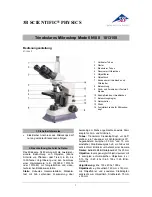
13
USING THE VERTICAL TUBE -
MODELS AY11230/11234
1. The vertical tube can be used for
instructional viewing or to
photograph
the image witrh a
digital camera or
micro TV
unit.
2. Loosen the retention screw, then rotate
the adjustment ring to change the
length of the vertical tube.
3. Make sure that both the images in
OPERATION (cont.)
SELECTING OBJECTIVE
MAGNIFICATION
1. There are two objectives. The lower
magnification objective has a greater
depth of field and view.
2. In order to observe the specimen
easily use the lower magnification
objective first. Then, by rotating the
case, the magnification can be
changed.
CHANGING THE INTERPUPILLARY
DISTANCE
1. The distance between the observer's
pupils is the interpupillary distance.
2. To adjust the interpupillary distance
rotate the prism caps until both eyes
coincide with the image in the
eyepiece.
FOCUSING
1. Remove the lens protective cover.
2. Place the specimen on the working
stage.
3. Focus the specimen with the left eye
first while turning the focus knob until
the image appears clear and sharp.
4. Rotate the right eyepiece ring until the
images in each eyepiece coincide and
are sharp and clear.
CHANGING THE BULB
1. Disconnect the power cord.
2. When the bulb is cool, remove the
oblique illuminator cap and remove
the halogen bulb with cap.
3. Replace with a new halogen bulb.
4. Open the window in the base plate and
replace the halogen lamp or
fluorescent lamp of transmitted
illuminator.
FOCUSING
1. Turn the focusing knob away or toward
you until a clear image is viewed.
2. If the image is unclear, adjust the
height of the elevator up or down,
then turn the focusing knob again.
ZOOM MAGNIFICATION
1. Turn the zoom magnification knob to
the desired magnification and field of
view.
2. In most situations, it is recommended
that you focus at the lowest
magnification, then move to a higher
magnification and re-focus as
necessary.
3. If the image is not clear to both eyes
at the same time, the diopter ring may
need adjustment.
DIOPTER RING ADJUSTMENT
1. To adjust the eyepiece for viewing with
or without eyeglasses and for
differences in acuity between the right
and left eyes, follow the following
steps:
a. Observe an image through the left
eyepiece and bring a specific point
into focus using the focus knob.
b. By turning the diopter ring
adjustment for the left eyepiece,
bring the same point into sharp
focus.
c.Then bring the same point into
focus through the right eyepiece
by turning the right diopter ring.
d.With more than one viewer, each
viewer should note their own
diopter ring position for the left
and right eyepieces, then before
viewing set the diopter ring
adjustments to that setting.
CHANGING THE BULB
1. Disconnect the power cord from the
electrical outlet.
2. When the bulb is cool, remove the
oblique illuminator cap and remove
the halogen bulb with cap.
3. Replace with a new halogen bulb.
4. Open the window in the base plate
and replace the halogen lamp or
fluorescent lamp of transmitted
illuminator.
Model AY11230
Model AY11234
14
Objectives
Revolving Turret
Coarse
Adjustment
Knob
MODEL AY11236
MICROSCOPE USAGE
BARSKA Model AY11236 is a powerful fixed power compound
microscope designed for biological studies such as specimen
examination. It can also be used for examining bacteria and
for general clinical and medical studies and other scientific uses.
CONSTRUCTION
BARSKA Model AY11236 is a fixed power compound microscope.
It is constructed with two optical paths at the same angle. It is
equipped with transmitted illumination. By using this instrument,
the user can observe specimens at magnification from 40x to
1000x by selecting the desired objective lens. Coarse and fine
focus adjustments provide accuracy and image detail. The rotating
head allows the user to position the eyepieces for maximum
viewing comfort and easy access to all adjustment knobs.
Model AY11236
Fine
Adjustment
Knob
Stage
Condenser
Focusing
Knob
Eyepiece
Stand
Lamp
On/Off
Switch
Lamp
Power
Cord
Rotating Head
Stage Clip
Adjustment
Interpupillary Slide Adjustment




























